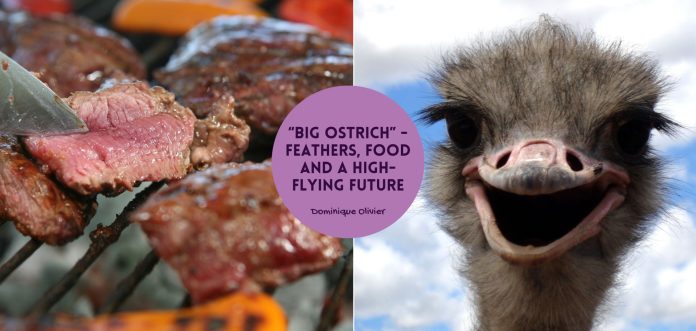Ostriches might not fly, but their numbers (and their impact) are soaring. From dusty Karoo farms to global sustainability debates, this big bird is quietly paving the future of meat production. Welcome to the surprising world of ostrich farming.
Once upon a time, before TikTok trends and Temu hauls, personal style was measured in plumage. Big, fluffy, overpriced plumage. In the late 1800s and early 1900s, ostrich feathers were the pinnacle of status, practically the iPhones of the Edwardian wardrobe. And if you wanted to know where the world’s most lucrative fashion fantasy was being farmed, you’d look no further than a sunbaked corner of South Africa called the Klein Karoo.
The big bird boom
This was ground zero for the Great Ostrich Feather Boom, a global trade frenzy so intense it gave rise to a new class of colonial elite known as ostrich barons. These weren’t your average bird farmers: they were feather tycoons. With fortunes plucked from the backs of birds, they built sprawling mansions known as feather palaces, complete with imported chandeliers, Italian tiles, and occasionally, their own train stations. As one does.
South Africa wasn’t alone in chasing the fluffy stuff. The United States, Australia, and even Egypt tried to get in on the action, leading to a global plume-off. But Oudtshoorn had the head start, the birds, and (crucially) the infrastructure. Ostrich farms multiplied at the speed of light – suddenly, everybody and their second cousin was an ostrich farmer. Feathers were harvested, sorted, curled, dyed every shade from blush to canary, and shipped off to Paris, the trendsetting mecca where fashion dreams went to be born or buried.
And in those days, Paris was firmly Team Ostrich.
Plumes exploded across Edwardian high society like glitter at a drag show. Hats weren’t just big back in those days, and fans, boas, jackets, and parasols followed suit. You could argue no woman of means left the house without at least one large, floppy, feathery accessory attached to her outfit.
Feathers even snuck into less glamorous corners of life. They made excellent dusters (thanks to their ability to create static electricity), and were popular in theatre and decor. Basically, if it could be flounced, it probably was.
Barons go bust
But with great demand came great drama. Before long, South Africa had a bit of a monopoly problem. Other countries wanted in, especially those with access to the prized Barbary ostriches of North Africa, who were known for their long, silky, high-value plumes. As rivals set up competing farms, South Africa doubled down by tightening export controls, investing in better breeding programmes, and getting very territorial about its birds.
The stakes were high. The ostrich feather trade was minting fortunes, attracting immigrants, and paying for roads, railways, and quite a few colonial bureaucrats’ salaries. But, like all speculative bubbles, this one was fragile. The entire industry rested on the whims of fashion, which has proven time and again to be a notoriously unstable foundation.
Then came 1914.
With the outbreak of World War I, society collectively decided it had bigger things to worry about than accessorising hats. Luxury spending tanked, imports dried up, and ostrich feathers – once traded at prices higher than gold by weight – suddenly weren’t worth the box they were packed in. Within months, the market collapsed.
Oudtshoorn’s lavish feather palaces were abandoned, sold off, or turned into guest houses (like this example). The Klein Karoo, which had bet big on birds, had to face the uncomfortable reality that the party was over. And like any economy that ties itself too closely to a single commodity (consider this a cautionary tale, oil nations), the fallout was painful.
Feathers, it turns out, aren’t forever.
Protein rather than plumes
In 2023, humanity ate roughly 140 million tons of poultry worldwide. That’s billions of chickens, turkeys and ducks, devoured in curries, nuggets, and Sunday roasts. Poultry now officially rules the meat-eating world, with pork in second place, and beef and veal somewhere further down the buffet table.
While most of us appreciate a good roast, we don’t really love our planet getting roasted in the process. The unfortunate truth is that meat production is a heavyweight in the climate change arena, with beef wearing the champion’s belt for most greenhouse gas emissions per bite. Add deforestation, water use, and a side of ethical anxiety, and you’ve got the perfect recipe for a global rethink. By 2040, it’s projected that 60% of all “meat” consumed will be vegetable-based, lab-grown, or something science hasn’t branded yet, while traditional meat will drop to just 40% of global consumption. Projections certainly aren’t facts, but that’s still a significant shift to consider.
Still, not all traditional meat sources are created equal, especially when it comes to efficiency. Chickens and pigs, for example, produce multiple offspring per breeding season. A single sow can produce as many as 20 piglets a year, while a commercial hen can lay over 300 eggs per breeding season. Meanwhile, your average cow is producing one calf a year, and maybe twins if the stars align.
More animals in a shorter timespan gives pig and poultry producers more data to work with, which means more control over feed, breeding, and genetic optimisation. In the past few decades, this is exactly how they’ve supercharged feed efficiency and meat yield, while lowering production costs and resource use. It’s also no accident that poultry is outpacing pork in global growth. In many regions, pork is off the menu for religious or cultural reasons, making chicken the default choice. But what if there was another option? One that worked for pork and beef-free populations, sipped water like a minimalist, and came with built-in climate creds?
You guessed correctly. It’s the ostrich.
Ostriches might not be invited to many farmyard children’s books (probably because Old MacDonald couldn’t imitate whatever sound an ostrich makes), but they’re quietly making a case for being the next big thing in sustainable meat. First off, they need about a third of the water that cattle do to produce the same amount of meat. They also need less space and less feed, and they are incredibly efficient at converting feed into bodyweight. They hit slaughter weight (around 90kg) in just 10 to 12 months, and reach breeding age at around 2 to 3 years. For context, cattle farmers require two years minimum just to raise one slaughter-ready animal.
The numbers do the talking. One ostrich yields around 27kg of meat after slaughter – a far cry from the 250kg you’ll get from a full-grown cow. But here’s where things get interesting: a cow produces just one calf per year, while a single ostrich can lay between 40 and 100 eggs in the same timeframe. So that’s 27kg of meat from the bird itself, plus up to 2,700kg from its combined offspring. And because ostriches grow faster and reach slaughter weight in under a year, those chicks will have grown up and hit the processing line in half the time it will take that cow’s lone calf.
Nutritionally, ostrich meat is also superior. It’s got the protein punch and a similar enough flavour and texture to beef but significantly less fat. It’s ideal for those trying to reduce their red meat intake without giving it up entirely, or for communities that need a non-pork protein source with legit sustainability credentials. So while cows continue their slow, methane-heavy waddle into the future, the ostrich might just be sprinting ahead. It’s fast. It’s efficient. It’s resource-light. And most importantly, it doesn’t require us to invent an expensive lab-grown alternative to red meat.
The ostrich barons of the future
Does that mean that South Africa is on the cusp of a second big bird boom? You would think so, having read this far. On paper, ostrich ticks all of the boxes for the meat of the future, and South Africa produces a lot of ostriches – 140,000 of them in 2024. What’s more, we produce some pretty good ostriches too. The Western Cape government owns the first dedicated ostrich research facility in the world. Since the 1970s, the province’s department of agriculture has been quietly running the show, digging into everything from genetics to production to feather quality, all in support of South Africa’s signature bird.
It started with a prestige breeding flock built from top-tier genetic stock donated by local farmers. The deal was that the department would maintain and improve the flock, and in return, the broader industry would benefit. Each year, offspring from this elite group are sold back to farmers, giving them direct access to the fruits of years of research, selective breeding and genetic gains.
But we’re not the only ones in the game. These days, you can find ostrich farms on almost every continent, and in countries and regions where you would never expect to see a big, flightless bird – China, Brazil, Israel, North and South America. Even parts of Europe are catching ostrich farm fever. Production is ramping up in order to meet the growing demand for ostrich leather and feather products, which are making a bit of a comeback in fashionable circles.
My guess, however, is that the real money is to be made in ostrich meat. Once the “exotic meat” angle wears off and Big Ostrich manages to land their sustainability talking points with a sustainably-minded consumer audience (Gen Z, anyone?), I reckon property prices in Oudtshoorn are ready to fly – even if the birds can’t.
About the author: Dominique Olivier

Dominique Olivier is the founder of human.writer, where she uses her love of storytelling and ideation to help brands solve problems.
She is a weekly columnist in Ghost Mail and collaborates with The Finance Ghost on Ghost Mail Weekender, a Sunday publication designed to help you be more interesting. She now also writes a regular column for Daily Maverick.
Dominique can be reached on LinkedIn here.





Brilliant article. I really enjoy your writing Dominique, please keep it up.
On a side note you can tell the Ghost that I am also a huge Alfa and Ferrari fan, really hoping for another LeMans victory!
And a perfect finish for Kubica in the end!
Great article Dominique, most though provoking and interesting.
Thank you Laurence! A pity we can’t invest in ostrich farms on the JSE, right?
And unlike cattle ostrich prefer semi-desert dry conditions
That’s 100% correct John – a very good point!
Interesting, informative and highly entertaining as always.
Thanks for reading Roy!